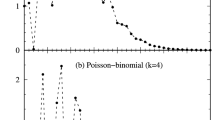Abstract
Many complex systems are characterized by power-law distributions. In this article, we show that for various examples of power-law distributions, including the two probably most popular ones, the Pareto law for the wealth distribution and Zipf’s law for the occurrence frequency of words in a written text, the power-law tails of the probability distributions can be decomposed into a statistical mixture of canonical equilibrium probability densities of the subsystems. While the interacting units or subsystems have canonical distributions at equilibrium, as predicted by canonical statistical mechanics, the heterogeneity of the shapes of their distributions leads to the appearance of a power-law.
Access this chapter
Tax calculation will be finalised at checkout
Purchases are for personal use only
Similar content being viewed by others
References
Beck, C.: Stretched exponentials from superstatistics. Physica (Amsterdam) 365A, 96 (2006)
Beck, C., Cohen, E.: Superstatistics. Physica A 322, 267–275 (2003)
Bhattacharya, K., Mukherjee, G., Manna, S.S.: Detailed simulation results for some wealth distribution models in econophysics. In: Chatterjee, A., S.Yarlagadda, Chakrabarti, B.K. (eds.) Econophysics of Wealth Distributions, p. 111. Springer (2005)
Chakraborti, A., Chakrabarti, B.K.: Statistical mechanics of money: how saving propensity affects its distribution. Eur. Phys. J. B 17, 167–170 (2000)
Chakraborti, A., Patriarca, M.: Gamma-distribution and wealth inequality. Pramana J. Phys. 71, 233 (2008)
Chakraborti, A., Patriarca, M.: Variational principle for the Pareto power law. Phys. Rev. Lett. 103, 228701 (2009)
Chatterjee, A., Chakrabarti, B.: Ideal-gas like markets: effect of savings. In: Chatterjee, A., S.Yarlagadda, Chakrabarti, B.K. (eds.) Econophysics of Wealth Distributions, pp. 79–92. Springer (2005)
Chatterjee, A., Chakrabarti, B.: Kinetic exchange models for income and wealth distributions. Eur. Phys. J. B 60, 135 (2007)
Chatterjee, A., Yarlagadda, S., Chakrabarti, B.K. (eds.): Econophysics of Wealth Distributions—Econophys-Kolkata I. Springer (2005)
Church, K.W., Gale, W.A.: Poisson mixtures. J. Natur. Lang. Eng. 103(2), 163 (1995)
Feller, W.: An Introduction to Probability Theory and its Applications, vol. 1 and 2. John Wiley & Sons, 2nd edn. (1966)
Gerlach, M., Altmann, E.G.: Scaling laws and fluctuations in the statistics of word frequencies. New J. Phys. 16, 113010 (2014)
Katriel, G.: Directed random market: the equilibrium distribution. Eur. Phys. J. B 88, 19 (2015)
Mandelbrot, B.: The Pareto-Levy law and the distribution of income. Int. Econ. Rev. 1, 79 (1960)
Newman, M.E.J.: Power laws, Pareto distributions and Zipf’s law. Contemp. Phys. 46, 323 (2005)
Patriarca, M., Chakraborti, A., Germano, G.: Influence of saving propensity on the power law tail of wealth distribution. Physica A 369, 723 (2006)
Patriarca, M., Chakraborti, A., Kaski, K.: Gibbs versus non-Gibbs distributions in money dynamics. Physica A 340, 334 (2004)
Patriarca, M., Chakraborti, A., Kaski, K.: Statistical model with a standard gamma distribution. Phys. Rev. E 70, 016104 (2004)
Patriarca, M., Chakraborti, A., Kaski, K., Germano, G.: Kinetic theory models for the distribution of wealth: Power law from overlap of exponentials. In: Chatterjee, A., S.Yarlagadda, Chakrabarti, B.K. (eds.) Econophysics of Wealth Distributions. p. 93. Springer (2005)
Patriarca, M., Chakraborti, A.: Kinetic exchange models: From molecular physics to social science. Am. J. Phys. 81(8), 618–623 (2013)
Patriarca, M., Chakraborti, A., Heinsalu, E., Germano, G.: Relaxation in statistical many-agent economy models. Eur. J. Phys. B 57, 219 (2007)
Patriarca , M., Heinsalu, E., Chakraborti, A.: Basic kinetic wealth-exchange models: common features and open problems. Eur. Phys. J. B 73, 145–153 (2010)
Treumann, R.A., Jaroschek, C.H.: Gibbsian theory of power-law distributions. Phys. Rev. Lett. 100, 155005 (2008)
Tsallis, C.: Possible generalization of Boltzmann-Gibbs statistics. J. Stat. Phys. 52, 479 (1988)
Acknowledgments
M.P., E.H., and A.C. acknowledge support from the Estonian Science Foundation Grant no. 9462 and the Institutional Research Funding IUT (IUT39-1) of the Estonian Ministry of Education and Research. A.C. acknowledges financial support from grant number BT/BI/03/004/2003(C) of Government of India, Ministry of Science and Technology, Department of Biotechnology, Bioinformatics Division. L.M. acknowledges the Estonian Research Council for supporting his work with the grant PUTJD110.
Author information
Authors and Affiliations
Corresponding author
Editor information
Editors and Affiliations
Appendix: Text analyzed
Appendix: Text analyzed
We constructed the text to be analyzed by merging in a single text file all the crime stories available on-line from the Gutenberg Project (www.gutenberg.org), mostly novels, by e.g. Christie, Collins, Davies, etc. The final file was a plain text file with a size of about 27 MB, containing about 50 millions words of which about 57,000 words were different from each other.
In order to extract the probability distribution of the occurrence frequency, we constructed a set of texts of equal size by dividing the original file into parts, each one containing a number \(N_W =\) 3,000 of words. The last part containing less than \(N_W\) words was neglected.
Rights and permissions
Copyright information
© 2016 Springer International Publishing Switzerland
About this paper
Cite this paper
Patriarca, M., Heinsalu, E., Marzola, L., Chakraborti, A., Kaski, K. (2016). Power-Laws as Statistical Mixtures. In: Battiston, S., De Pellegrini, F., Caldarelli, G., Merelli, E. (eds) Proceedings of ECCS 2014. Springer Proceedings in Complexity. Springer, Cham. https://doi.org/10.1007/978-3-319-29228-1_23
Download citation
DOI: https://doi.org/10.1007/978-3-319-29228-1_23
Published:
Publisher Name: Springer, Cham
Print ISBN: 978-3-319-29226-7
Online ISBN: 978-3-319-29228-1
eBook Packages: Physics and AstronomyPhysics and Astronomy (R0)



